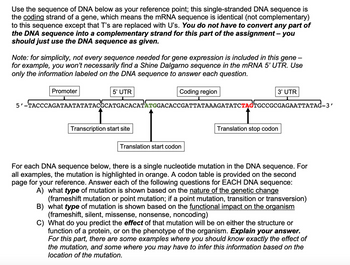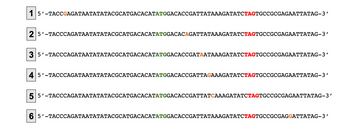
Human Anatomy & Physiology (11th Edition)
11th Edition
ISBN: 9780134580999
Author: Elaine N. Marieb, Katja N. Hoehn
Publisher: PEARSON
expand_more
expand_more
format_list_bulleted
Concept explainers
Question
Please answer A, B, and C for codon sequence 1 only

Transcribed Image Text:Use the sequence of DNA below as your reference point; this single-stranded DNA sequence is
the coding strand of a gene, which means the mRNA sequence is identical (not complementary)
to this sequence except that T's are replaced with U's. You do not have to convert any part of
the DNA sequence into a complementary strand for this part of the assignment - you
should just use the DNA sequence as given.
Note: for simplicity, not every sequence needed for gene expression is included in this gene -
for example, you won't necessarily find a Shine Dalgarno sequence in the mRNA 5' UTR. Use
only the information labeled on the DNA sequence to answer each question.
Promoter
5' UTR
Coding region
Transcription start site
5'-TACCCAGATAATATATACGCATGACACATATGGACACCGATTATAAAGATATCTĄCTGCCGCGAGAATTATAG-3′
3' UTR
Translation start codon
Translation stop codon
For each DNA sequence below, there is a single nucleotide mutation in the DNA sequence. For
all examples, the mutation is highlighted in orange. A codon table is provided on the second
page for your reference. Answer each of the following questions for EACH DNA sequence:
A) what type of mutation is shown based on the nature of the genetic change
(frameshift mutation or point mutation; if a point mutation, transition or transversion)
B) what type of mutation is shown based on the functional impact on the organism
(frameshift, silent, missense, nonsense, noncoding)
C) What do you predict the effect of that mutation will be on either the structure or
function of a protein, or on the phenotype of the organism. Explain your answer.
For this part, there are some examples where you should know exactly the effect of
the mutation, and some where you may have to infer this information based on the
location of the mutation.

Transcribed Image Text:15'-TACCGAGATAATATATACGCATGACACATATGGACACCGATTATAAAGATATCTAGTGCCGCGAGAATTATAG-3'
2 5'-TACCCAGATAATATATACGCATGACACATATGGACACAGATTATAAAGATATCTAGTGCCGCGAGAATTATAG-3′
3 5'-TACCCAGATAATATATACGCATGACACATATGGACACCGATAATAAAGATATCTAGTGCCGCGAGAATTATAG-3'
4 5'-TACCCAGATAATATATACGCATGACACATATGGACACCGATTAGAAAGATATCTAGTGCCGCGAGAATTATAG-3'
5 5'-TACCCAGATAATATATACGCATGACACATATGGACACCGATTATCAAAGATATCTAGTGCCGCGAGAATTATAG-3′
65'-TACCCAGATAATATATACGCATGACACATATGGACACCGATTATAAAGATATCTAGTGCCGCGAGGATTATAG-3′
Expert Solution
This question has been solved!
Explore an expertly crafted, step-by-step solution for a thorough understanding of key concepts.
Step by stepSolved in 2 steps

Knowledge Booster
Learn more about
Need a deep-dive on the concept behind this application? Look no further. Learn more about this topic, biology and related others by exploring similar questions and additional content below.Similar questions
- What would be the percentage of G, C, A, and T in each column? Have to calculate the nucleotide frequency from my sequence.arrow_forwardA elearn.squ.edu.om/mod/quiz/attempt.php?attempt-D1335328&cmid%3D6971498&page%=D1 System (Academic) Answer: If a sequence of DNA has 20% Guanine bases how many Adenines would it have? Select one: О а. 10% ОБ.20% O c. 30% O d. 40% O e. 50% A scientist noticed that his sample of cvanobacteria moves towards the side of the petn diarrow_forwardTranslate to amino acids the strand using the Genetic Code chart. Remember to use the start and stop sequences. UGCGAUGGCAAUCGGUGUACCCCUGACUGAGCarrow_forward
- Identify (and highlight or underline) the one nucleotide difference between the original (left) and altered (right) sequencesarrow_forwardPart of a sequence of DNA from a person without this genetic disease is: TAG TAA AAA CCA CCC AGG Part of a sequence of DNA from a person with a genetic disease is: TAG TAA CCA CCC AGG The possible codons for some amino acids are shown in the table. Amino acid Codons glycine GGU GGC GGA GGG isoleucine AUU AUC phenylalanine UUU UUC serine UCU UCC UCA UCG Which amino acid is missing from a person with this genetic disease? serine glycine O phenylalanine isoleucinearrow_forwardCan you help me solve this sequence question and identifty the mutation?arrow_forward
arrow_back_ios
SEE MORE QUESTIONS
arrow_forward_ios
Recommended textbooks for you
 Human Anatomy & Physiology (11th Edition)BiologyISBN:9780134580999Author:Elaine N. Marieb, Katja N. HoehnPublisher:PEARSON
Human Anatomy & Physiology (11th Edition)BiologyISBN:9780134580999Author:Elaine N. Marieb, Katja N. HoehnPublisher:PEARSON Biology 2eBiologyISBN:9781947172517Author:Matthew Douglas, Jung Choi, Mary Ann ClarkPublisher:OpenStax
Biology 2eBiologyISBN:9781947172517Author:Matthew Douglas, Jung Choi, Mary Ann ClarkPublisher:OpenStax Anatomy & PhysiologyBiologyISBN:9781259398629Author:McKinley, Michael P., O'loughlin, Valerie Dean, Bidle, Theresa StouterPublisher:Mcgraw Hill Education,
Anatomy & PhysiologyBiologyISBN:9781259398629Author:McKinley, Michael P., O'loughlin, Valerie Dean, Bidle, Theresa StouterPublisher:Mcgraw Hill Education, Molecular Biology of the Cell (Sixth Edition)BiologyISBN:9780815344322Author:Bruce Alberts, Alexander D. Johnson, Julian Lewis, David Morgan, Martin Raff, Keith Roberts, Peter WalterPublisher:W. W. Norton & Company
Molecular Biology of the Cell (Sixth Edition)BiologyISBN:9780815344322Author:Bruce Alberts, Alexander D. Johnson, Julian Lewis, David Morgan, Martin Raff, Keith Roberts, Peter WalterPublisher:W. W. Norton & Company Laboratory Manual For Human Anatomy & PhysiologyBiologyISBN:9781260159363Author:Martin, Terry R., Prentice-craver, CynthiaPublisher:McGraw-Hill Publishing Co.
Laboratory Manual For Human Anatomy & PhysiologyBiologyISBN:9781260159363Author:Martin, Terry R., Prentice-craver, CynthiaPublisher:McGraw-Hill Publishing Co. Inquiry Into Life (16th Edition)BiologyISBN:9781260231700Author:Sylvia S. Mader, Michael WindelspechtPublisher:McGraw Hill Education
Inquiry Into Life (16th Edition)BiologyISBN:9781260231700Author:Sylvia S. Mader, Michael WindelspechtPublisher:McGraw Hill Education

Human Anatomy & Physiology (11th Edition)
Biology
ISBN:9780134580999
Author:Elaine N. Marieb, Katja N. Hoehn
Publisher:PEARSON

Biology 2e
Biology
ISBN:9781947172517
Author:Matthew Douglas, Jung Choi, Mary Ann Clark
Publisher:OpenStax

Anatomy & Physiology
Biology
ISBN:9781259398629
Author:McKinley, Michael P., O'loughlin, Valerie Dean, Bidle, Theresa Stouter
Publisher:Mcgraw Hill Education,

Molecular Biology of the Cell (Sixth Edition)
Biology
ISBN:9780815344322
Author:Bruce Alberts, Alexander D. Johnson, Julian Lewis, David Morgan, Martin Raff, Keith Roberts, Peter Walter
Publisher:W. W. Norton & Company

Laboratory Manual For Human Anatomy & Physiology
Biology
ISBN:9781260159363
Author:Martin, Terry R., Prentice-craver, Cynthia
Publisher:McGraw-Hill Publishing Co.

Inquiry Into Life (16th Edition)
Biology
ISBN:9781260231700
Author:Sylvia S. Mader, Michael Windelspecht
Publisher:McGraw Hill Education